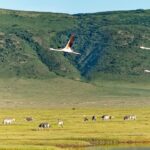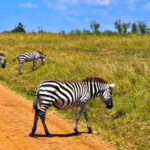Rubondo Island National Park is found in the southwestern part of Lake Victoria which is the main freshwater lake on the continent. The national park is comprised of a total of 9 islands and most of them are encompassed in a thick forest. The other part of the park is covered by grassland, wild jasmine, reed swamps, plus vast woodland savannah. This undamaged and less visited destination in Tanzania is a paradise to a variety of game, reptiles, birds, and insects and is also a sport fishing and breeding area.

Crocodiles in Rubondo Island National Park
The deserted exotic beaches are found just next to the virgin forest, from where bushbucks patrol through tamarinds, wild palms, as well as sycamore-fig trees. The papyrus swamps and in the forest are believed to be home to the amphibian sitatunga. Among other animals you can spot on the island park include primates for example chimpanzees, vervet monkeys and colobus monkeys, rare suni antelopes, giraffes, bushbucks, genets, hippos swimming over the lake shores, and the marsh mongoose. Crocodiles also can be spotted on the sandy banks of the lake.
The island park is blessed with a variety of different bird species that offer music for the rising sun and the dusk. You will always be able to spot fish martial eagles on the lake as they will be looking for floating fish left by the fishermen. Many other species of bird can be observed on this island park that consists including cuckoos, bee-eaters, sunbirds, kingfishers, herons, storks, spoonbills, and African grey parrots which were re-introduced in the park from initiatives to clump their poaching and exportation. The lake furthermore attracts numerous Euroasia migratory birds for the period of the northern wintertime.
Getting there

Rubondo Airstrip
By air, the park can be accessed by catching a flight from Mwanza, Arusha, Serengeti, and Lake Manyara, during the peak season, and also charter plains are available in the low season.
By road from Mwanza and later board a boat to the park
What to do
Sport fishing is one of the famous and interesting activities to do in the park for equally the locals as well as the tourists. Species of fish caught consist of record-breaking Nile Perch weighing up to 100kg, delicious tilapia, and others.
Other tourist activities you can enjoy in the park consist of nature walks to the naturalists through the wide range of wild flowering fields. You will discover forty different orchids, and various sweet, unique scents over the forest besides fireball lilies, especially in the rainy time of the year.
When to go
The dry period is right from June to August and is good for wildlife viewing, sport fishing, and also walking safaris in the flowering wildflowers. Butterflies make an added chase to the hikes.
The wet time of year starts around November and ends in March. December up to February is mostly an interval for inflows of migrant birds originating from far East Asia.
Accommodation
One luxury tented camp, park bandas, and also a camping site. Hostels are for school groupings.



